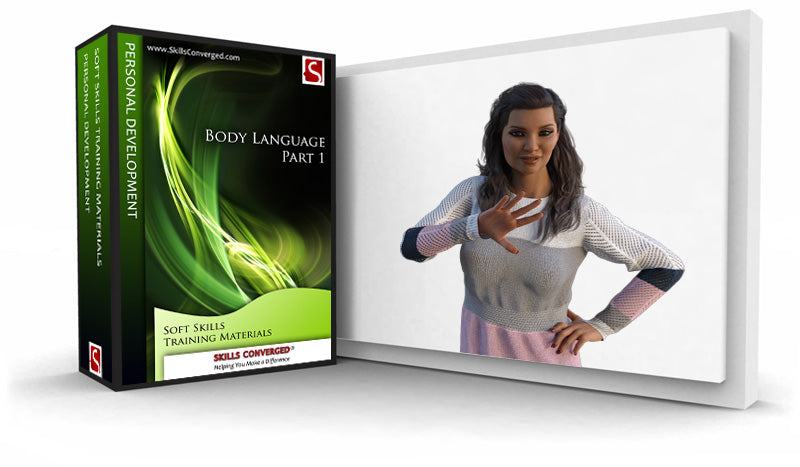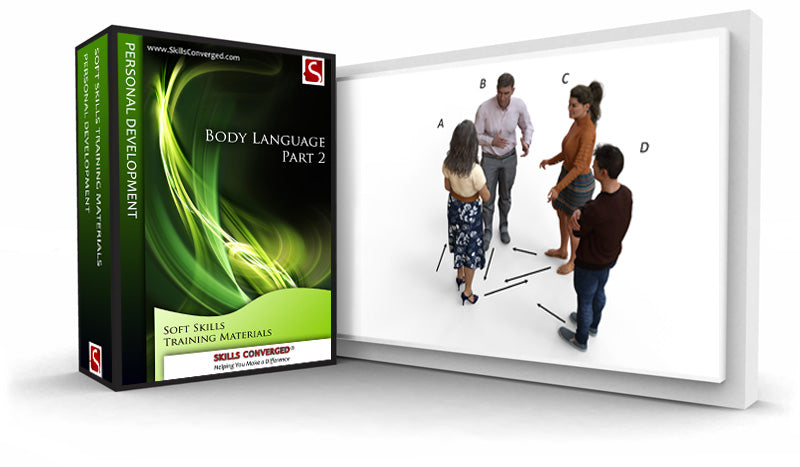
Personal Space, Territory and Physical Contact
Can you read people just by their distance from each other? A man and a woman are walking down the street. They are about a meter or more apart from each other. As they walk, every now and then they get slightly closer, but they keep their distance around the one meter average. Sometimes they look like they bounce off from each other as they adjust their direction making sure they don’t bump into each other. What does their body language suggest?
Most people would agree that the two are probably not an intimate couple or two friends who know each other well. Perhaps they are colleagues, or may be an estate agent on the way to show a property to a customer.
Now suppose you observe that when the man and woman walk together, every now and then they bump into each other physically, fairly casually and carry on as normal. Even if they are not holding hands, their body language suggests that they must be a couple or be in a very close relationship.
A simple observation of distance between people can tell you a lot about people and their relationships with each other. The study of this distance is known as proxemics within the field of body language and was introduced by Edward T. Hall in 1966. It is the study of measuring distances between people in different social contexts.
Personal Space
It turns out that we respond differently as a person enters different zones of proximity. The zones are as follows:

Intimate / Personal Zone
X < 45 cm
Reserved for loved ones, family and children.
Friend Zone
45 cm < X < 1.2 m
This is the zone for friends, associates and colleagues. You are familiar with them and you see them occasionally.
Social Zone
1.2 m < X < 3.6 m
This is the zone for new acquaintances and newly formed groups or strangers. Examples are a customer who just walked into the store, a manager of another company visiting your premises or a new colleague.
Audience Zone
X > 3.6 m
This is the zone for public audience and is used when giving a lecture, a presentation or a public speaking.
Note that there is a bit of an overlap between the friends zone and the public zone. After all there are always exceptions to the norm. In addition you should also consider cultural biases. Some cultures are more comfortable to touch each other (such as Brazil, Mexico and Italy) while others may not be so comfortable (such as UK, Germany and Norway).
Territorial Bias
While personal zone accompanies a person as he moves in an environment, territoriality is relatively stationary. Humans are strongly territorial. Once a territory is claimed it becomes a safety zone where a person can rest without constantly worrying about a sudden entry into his personal space. Humans, like other members of the animal kingdom, defend their territories vigorously against all invasions. We are simply hard-wired to do this and it is a strong part of human behaviour and decision making; something you can take advantage of to predict a person’s next moves or body language.
People use all sorts of strategies to claim a territory. The standard practice is to customise and personalise an environment. Examples include, placing a jacket over a chair, putting a family picture on a desk, hanging certificates in an office and leaving personal belongings even as simple as a water bottle to claim a table.
You can use territorial bias to predict behaviour since just about everyone follows this hardwired code. Here are some popular situations that illustrate territorial bias:
- Lectures and conferences. Consider attending a series of lectures. In the second session of the lectures, the audience is likely to go back to the same seats they were in during the first lecture. As an example, if you have been in this situation before and have gone back to discover that someone else has taken your seat, it is likely that you would have felt a strong discomfort and possible irritation.
- Car lift. A number of people are sharing a car in a journey. On the way out they sit randomly. On the way back with the same set of people, everyone goes back to the same seat they had occupied on the way out.
- Sports hall. A group of people meet to play badminton every week as part of their club night. They bring their sport bags and badminton racquets. Note that most people, on arrival, tend to place their gear in the same exact spot near the benches around the badminton court as they had in previous weeks. New members occasionally disrupt the placements. If there are no new members, it is highly likely that the placement would not change from week to week.
- Regular pub attendance. People, who regularly attend their local pub, tend to go to their favourite spot in the pub, which also explains the tendency to hang around with the same group of people.
- Hot desking. People who regularly need to select a hot desk from a set of desks in a particular office tend to select the same hot desk they chose the first time.
Introverts versus Extroverts
Introverts prefer privacy in their environment and their mind. Introverts get their energy from tasks and activities as opposed to people. Extended interactions with people can be exhausting for them.
In contrast, extroverts get their energy from interacting with people and stimulating environments. They are generally speaking more sociable and enjoy talking.
This bias to privacy for introverts means that they are more territorial than extroverts. When dealing with people, always consider their natural bias toward introversion or extroversion and respect their preference. Although the society seems to favour extrovert behaviour, introversion should not be ignored.
Claiming Objects
Territorial bias extends to objects and the environment around us as well and we tend to be very conscious of invasions or claims by others. In order to avoid annoying people, respect their territory. Consider the following techniques:
- Beware of people’s territorial claims. People claim ownership to the place they regularly visit, whether it is an office room, an office cubicle, a desk or an area on the shop floor of a manufacturing plant. In people’s minds, anything in their area is considered theirs and if anyone touches any objects or interacts with them, they will become concerned and may strongly dislike it. In more extreme cases, it may lead to strong discomfort, aggression or even a fight!
- Respect a person’s desk. The most common application for this body language technique is when you visit a person’s office and you are standing or sitting by their desk. Consider their desk and office as their territory and the objects an extension of them. Do not touch the contents of the desk such as picking up a pen, papers, a picture frame, a report, a flyer, or even a stapler without explicit permission. Even though the gesture might be trivial, the other person may unconsciously dislike you. This can backfire in cases where you need something from the person such as a job in an interview, extra resources from a manager or a better deal in a sales pitch. If you want to use or touch something, ask for permission first. The request will be taken as a sign of respect for that person’s territory and will have a positive impact on their evaluation of you.
Psychological Pressure through Invasion of Personal Space
Invasion of personal space is a favourite strategy of those who want to dominate a person. For example, police interrogators routinely use this technique to violate the personal space of a suspect. Multiple officers invade the personal space and they will go all the way into the personal zone, possibly touching and handling the suspect. Since the suspect has little say in defending his personal space, he will be under a psychological pressure which is indeed what the officers want to achieve.
The same body language technique is also used by dominant and aggressive people who want to own you. When you find yourself in such a situation, find ways to physically prevent them from doing so, though this may not always be easy once the invasion has already taken place. For repeat offenders, consider a pre-emptive approach to prevent them from coming close to you. Use strategies such as using a desk as a barrier, calling them on the phone as opposed to meeting them or asking others to be present in a meeting and use them as a buffer to prevent a space invader in invading your personal zone.

Invading a person's personal space will make them uncomfortable
Blocking a Passage
The leader of a rival team comes to your office to have a chat about on-going projects. He doesn’t seem to be happy with the way your team has been utilising the CNC machine, effectively hugging resources at the expense of the other team. The rival leader stands at the doorway of your office, blocking the entrance and leans against the wall. How do you read his body language?
The gesture is aggressive. He is laying claim to your office, your territory. He is blocking the way physically, perhaps so that you cannot escape. Remember, this might not be a conscious thought and the intention is not necessary to physically block you. The posture is just a manifestation of what is going on in his mind at the time, expressed physically. He is also leaning against the wall and is perhaps crossing his legs which suggests lack of confidence or being unsure of his position; hence seeking a physical support. How would you respond to such a move?
You would need to break this posture, but how would you approach it? Suppose you show that you want to leave the office, perhaps to attend to an urgent task. However, this means you are ignoring the claim, possibly showing disrespect and then moving up to stand squarely in front of the person and expect him to move out of the way so you can leave the office. This is a confrontational move and is likely to escalate the situation rather than resolve it. The confrontation could also be exactly what the rival leader wants.

Aggressive or Defensive?
Instead, your first priority should be to force the person to change his posture, but doing so indirectly and without possible confrontation. Remember, the mind follows the body and the body follows the mind. Once out of a posture, he is more likely to become less aggressive and more receptive to your ideas or explanations. In this example, you can ask him to come over to your desk, perhaps to show him something on your computer, or show him a report which is related to the topic of the conversation. The curiosity and the fact that you seem to be cooperative will be a strong incentive for him to leave the doorway and come to you. This simple move will break his posture and gives the advantage to you as you now have the initiative. You have managed to indirectly resolve the tense situation, purely by thinking about body language; such is the power of reading non-verbal signals and influencing a person’s body language.

All Articles in the Series
A Comprehensive Guide to Body Language
Origins of Humans and Body Language
How to Read People Using Their Body Language
How to Influence Your Emotional State Using Body Language
Body Language Across Different Cultures
Body Language of Defensive Attitude
Body Language of Good First Impressions
How to Improve Personal Impact
Continue Reading the Body Language Series..
Body Language Guide Article IndexBody Language Training Materials
Body Language Exercises
Explore our collection of free body language training exercises and articles:



Use this body language exercise at the beginning of a session before covering non-verbal communication. The aim is to find out how much delegates already know about this topic and...
The aim of this exercise is to get the delegates think about body language and gestures and observe how such signals can be instrumental while communicating. The training exercise illustrates...
This is an exercise in communication with the aim to increase awareness of body language and non-verbal communications.







